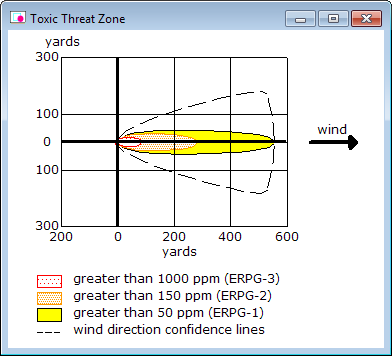ALOHA Software

ALOHA® is the hazard modeling program for the CAMEO® software suite, which is used widely to plan for and respond to chemical emergencies.
ALOHA allows you to enter details about a real or potential chemical release, and then it will generate threat zone estimates for various types of hazards. ALOHA can model toxic gas clouds, flammable gas clouds, BLEVEs (Boiling Liquid Expanding Vapor Explosions), jet fires, pool fires, and vapor cloud explosions. The threat zone estimates are shown on a grid in ALOHA, and they can also be plotted on maps in MARPLOT®, Esri's ArcMap, Google Earth, and Google Maps. The red threat zone represents the worst hazard level, and the orange and yellow threat zones represent areas of decreasing hazard.
Downloading ALOHA
Download ALOHA for Windows (Version 5.4.7, Sept 2016, 7.33 MB EXE)
Download ALOHA for Mac (Version 5.4.7, Sept 2016, 9.63 MB DMG); additional Mac instructions
The Windows version can be run on Windows 7, Windows 8.1, and Windows 10 operating systems. The Macintosh version can be run on Mountain Lion (10.8), Mavericks (10.9), Yosemite (10.10), and El Capitan (10.11) operating systems. Operating systems not listed here have not been tested and are not supported.
If you already have an older version of ALOHA: It is best to install the new ALOHA application in the same folder as your previous version. This will replace the old application with the new one, while still maintaining all of your settings. Any chemical information that you have added to the chemical library will not be saved and you will need to re-enter that information.
Learning More About ALOHA
For a brief summary of the ALOHA program and its capabilities, download the ALOHA fact sheet (PDF).(2pp, 471 KB, About PDF)
ALOHA's help topics include an example problem that you can work through to familiarize yourself with the program. You can also download the ALOHA Examples (PDF), which has three additional step-by-step fictional example scenarios.(53pp, 1.9 MB, About PDF)
For additional information on using ALOHA (such as FAQs, a Level of Concern guide, and the Ask. Dr. ALOHA articles), see the ALOHA pages on the NOAA Office of Response and Restoration site.
For information about ALOHA's models and equations, as well as other background information, download the ALOHA Technical Documentation (PDF).(96 pp, 1.3 MB, About PDF)
Significant Changes in ALOHA Version 5.4.7
- Updated chemical library, including new DIPPR chemical data and new toxic Levels of Concern (PACs and ERPGs).
- Made minor update to the RAILCAR source strength model for pressurized liquid tanks where a stationary cloud or "mist pool" is predicted to form.
- Revised helps.
- Made additional minor changes and bug fixes.
Getting Help
You can report software bugs or obtain additional assistance by emailing the RMP Reporting Center (RMPRC@epacdx.net), or by calling the CAMEO help desk at (703) 227-7650 on weekdays from 8 AM to 4:30 PM, Eastern Time.
